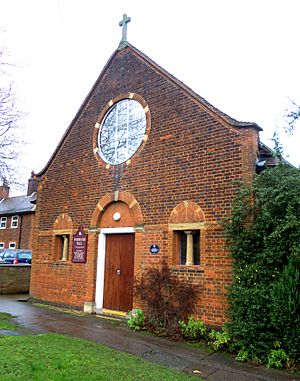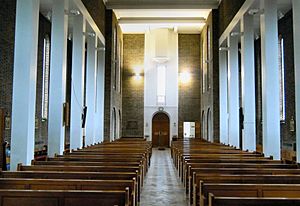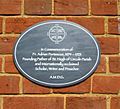Church of St Hugh of Lincoln, Letchworth facts for kids
Quick facts for kids St Hugh of Lincoln, Letchworth |
|
|---|---|
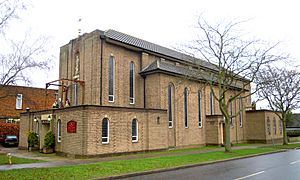
Church of St Hugh of Lincoln in Letchworth in 2017
|
|
| Denomination | Roman Catholic |
| Website | [1] |
| History | |
| Dedication | St Hugh of Lincoln |
| Consecrated | 2007 |
| Administration | |
| Deanery | Stevenage |
| Diocese | Westminster |
The Church of St Hugh of Lincoln is a Catholic church located in Letchworth, Hertfordshire. It was started by a smart priest named Adrian Fortescue. The first church building was officially opened in 1908. It was named after Saint Hugh of Lincoln. The church building you see today was built later, in 1963. This church is part of the Westminster Diocese.
The First Church: 1907-1963
When Adrian Fortescue became the priest in charge of Letchworth in November 1907, he had a big job: building a church from nothing! He designed much of the first church himself and even paid for a lot of it. Records show he gave more money each year than he earned.
The first small church opened in 1908 on Pixmore Way. It was designed by Sir Charles Spooner. It had a Romanesque style front and was meant to be a temporary church. A house for the priest was added in 1909. A bishop named Patrick Fenton blessed the church on September 6, 1908. It was dedicated to Saint Hugh of Lincoln.
Adrian Fortescue was very interested in the Byzantine Church. He also knew many artists from the Arts and Crafts Movement. Their ideas influenced the church's design, especially inside. Some of the special items and artwork from this old church are still used in the new one today.
This original church building is now used as the Church Hall. It is called 'Fortescue Hall' to remember its founder, Adrian Fortescue. Over time, this first church became well-known for its beautiful music and special church services.
The Current Church Building
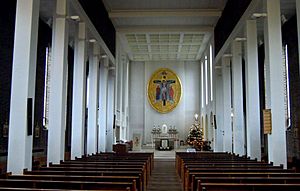
The first church was always meant to be temporary. Adrian Fortescue even drew plans for a new, bigger church before he passed away in 1923. In 1938, a new design was created by John Edward Dixon-Spain. Building was supposed to start in September 1939, but World War II began, stopping the plans.
Work finally started in May 1961. The new church mostly followed Dixon-Spain's modern Romanesque design. John Willmott & Sons from Hitchin were the builders. The church has a strong frame made of concrete and steel. The outside is covered in brick, with stone around the windows and doors.
The main part of the church, called the nave, is wide and long. It has narrow side areas called aisles. At the back, there's a narthex (entrance area) and a baptistery (where baptisms happen). At the front, there's the Sanctuary and a Lady Chapel to the south. The original flat roof was later changed to a slightly sloped concrete roof.
Cardinal William Godfrey blessed the foundation stone on April 7, 1962. The very first Mass (church service) was held on February 21, 1963. Several items from the old church were moved into the new one. These included the holy water font, the ciborium (a special container, removed in 2007), and four stained-glass windows. A stone tablet remembering Adrian Fortescue was also moved.
The unique square alabaster baptismal font was also brought from the old church. It was designed by Spooner in 1911. It stands on stone columns and has an inscription. This inscription remembers Dr. Edmond Fauriel Trevelyan, who passed away in 1911. He was a doctor and a local judge.
The Lady Chapel has a marble altar with carvings of loaves and fishes. Three stained-glass panels showing the Virgin Mary and Jesus, Saint Hugh, and Saint Lawrence were moved here from the old church. The engraved stone memorial to Adrian Fortescue is also in this chapel.
In the Sanctuary, there is a very large carved icon (a religious image) of the Crucifixion of Jesus. It is sixteen feet wide and was made by Stephen Foster. In January 2007, the Sanctuary and other parts of the church were updated. This was done to fit modern church service needs. On November 24, 2007, Bishop George Stack officially consecrated the church. This was part of the celebrations for the church's 100th anniversary. In November 2013, Archbishop Vincent Nichols held a Mass in the church. This celebrated the 50th anniversary of the current church building.
Images for kids
-
The alabaster baptismal font dates to 1911


